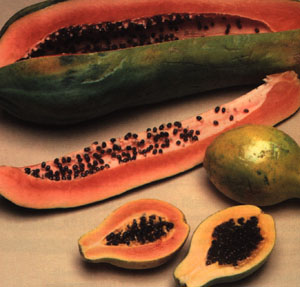
FoodFood InformationFruitTropical
The Papaya, believed to have originated in Central America, is now an
important fruit crop in all tropical areas of the world. It is most unusual.
Botanically it is a berry that grows on a tall, bee like plant that reaches
a height of twenty feet. The fruit is pear-shaped, but cuts and tastes like
a cantaloupe. Like a melon, the countless, tiny, round black seeds are contained
not in the flesh of the fruit but in a cavity. Papayas, often referred to
as melons that grow on trees, are in season twelve months of the year.
Just as the pineapple originated in Brazil and did well when introduced
on the islands in the Caribbean basin, but reached its finest hour when
transplanted to Hawaii, the papaya followed the same path to success. Until
after World War 11, unless you visited the Hawaiian Islands, you could not
enjoy the fine flavor of the Hawaiian pineapple or the Hawaiian papaya.
Today, thanks to the speed of the jet plane, both items are available in
most stateside areas.
Papayas grow like weeds in the tropics. Puerto Rico, the Bahamas, and Florida
have varieties that attain great size, some as big as a football. Hawaiian
papayas are carefully tended and nourished. Almost all are of uniform size
and are identical in appearance. Usually a light green in color when harvested,
they color up to a golden yellow as they ripen, following the same changing
color pattern as bananas. Nearly all the papayas sold in North America are
grown in Hawaii and arrive via air freight.
The main Hawaiian variety is called Solo, but there is nothing solo
about the way they grow. I have seen hundreds on a single papaya tree. The
Solo is a yellow fleshed variety. Recently there has been an increased supply
of an orange-pink-fleshed variety called the Sunrise. Both varieties are
equal in flavor and texture and will ripen at room temperature.
Fully ripened papayas are golden yellow in color. When they are green in
color they are not mature and lack flavor. The best way to prepare them
is to cut them lengthwise, from stem end to blossom end, and scoop out the
numerous black seeds. Then add a few drops of fresh lime or lemon juice
to jazz up the rather bland but sweet flavor. A ripe papaya will have a
flavor and texture very similar to that of a ripe cantaloupe.
Due to the great distance that papayas have to travel, they are usually
quite costly. They are not a good buy when the usually less costly and more
flavorful cantaloupes are in season, but when melons are out of season-usually
in December and January, papayas can be an excellent substitute. Although
available twelve months of the year, they are in short supply and at yearly
high prices from March 15 to May 15.

WHEN TO BUY: Available year-round
WHAT TO LOOK FOR: Firm, pale green, or pale yellow fruit
HOW TO STORE: Ripen at room temperature; preferable not to refrigerate
Deamer 5/97